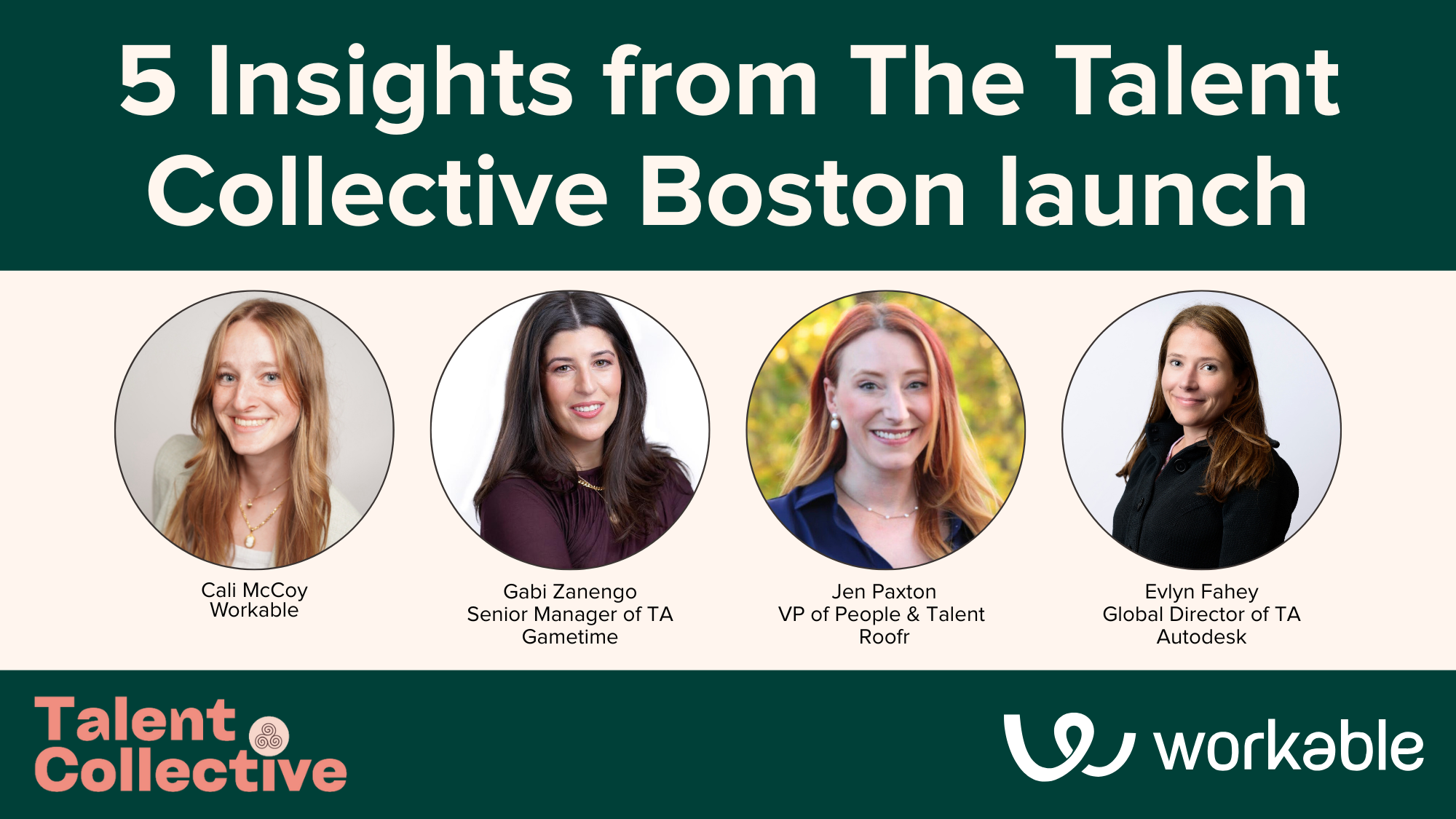Tech recruitment in London: Luring and sourcing top tech talent

As a recruiter or hiring manager in the hypercompetitive tech recruitment landscape, you’re likely fighting tooth and nail for those coveted developers who, frustratingly enough for you, have the luxury to pick and choose from numerous jobs. The shortage of tech talent is tangible in many tech hubs around the world. We at Workable wanted to get more insight so we decided to ask the experts – the candidates themselves – on the topic of tech recruitment.
We chose three major tech hubs based on global rankings of the best cities for tech startups – Boston, San Francisco and London – all featured in the top 5. The struggle for hiring and sourcing tech talent is the same in all three: many job opportunities, but not quite the talent. To help unravel and resolve this problem, we spoke to developers in Boston and San Francisco who revealed fascinating insights on how to best hire tech talent.
And now, we complete the puzzle with our most recent event in London where Balderton Capital, a London-based venture capital firm focusing on tech startups, opened their doors for a conversation about luring top talent in the London tech scene. More than 200 signed up for the event titled How to hire: Top Tech Talent, which took place on Wednesday, July 3, 2019. On the panel were:
- Paul Ingles, Head of Engineering at uSwitch
- Rahma Javed, Director of Engineering at Deliveroo
- David Whitney, Director, C#, Agile, technical leadership and consultant, Electric Head Software
Workable’s VP of Customer Advocacy Matt Buckland minced no words in his introduction of the panelists, somewhat tongue in cheek: “These are the people where you’d think twice before hitting send. Just those people, where you’re the little bit the right type of afraid. That’s this panel.”
Tech, of course, doesn’t change dramatically from city to city or country to country. But it was interesting to note the differences in tech recruitment challenges – or more so, what attracts tech talent – between the Boston and London tech scenes. Rahma, whose career spanned IBM and BlackBerry outside of Toronto and Microsoft and WealthFront in the Silicon Valley, alluded to that appeal of working in tech:
“That’s probably been the more exciting or interesting part for me, just to be in different sort of tech cultures, being able to figure out what the strengths and weaknesses are in each of these specific tech cultures. Then bringing that along with myself.”
The ensuing discussion was vibrant, thoughtful, and above all, insightful. Here are our top five takeaways from London’s Top Tech Talent event:
1. Know that there’s a London tech talent community
One theme that stood out was the presence of a London tech talent community. That network is dynamic, said David:
“We all know who’s hiring, we all know what the culture’s like inside companies, because people talk and share. Especially if you go to events or on the speaker circuit, or are just in WhatsApp groups full of people that work at different places. We all talk.”
Paul echoed the same sentiment, that when those in tech recruitment approach him, he’s quick to know about the company simply via their reputation:
“I’ll know through networks whether those companies are in high-growth periods. … I’ll go to meetups and see conference presentations, and get a feel for the company or the technology and stuff. I [put those] together to figure out the high-quality stuff.”
David added that candidates will go to their peers before they go to a recruiter:
“Here’s a life hack for recruiters. Turn up at sponsor events, and actually stay for the whole thing, and stay in the bar afterwards, and don’t pitch. Just make friends.”
He added that he himself often refers candidates: “[Candidates] will come to their network before they come to specific people dedicated to hiring,” adding that he’ll refer them to those recruiters who do show up, who know the market, and interact with others.
The takeaway:
Assume that candidates already know a little bit about you via their research and their professional network. And remember to nurture one of the most powerful influencers in that network: your current employee base. Word of mouth is more powerful than any tech recruitment marketing campaign you set out on.
2. Share details on your existing team
All three panelists agreed that while the job is important, it’s almost more important to know who they’ll be working with and for. Again, your current work climate and employee base become crucial to your tech recruitment strategy.
Rahma cited LinkedIn as a tool to learn about a company: “Oftentimes when you’re interested in companies … you look at who all the other people are based in that company right now. What are their backgrounds? What does this company value versus not?”
Paul shared an anecdote about a challenging assessment that he had to do as part of the candidate process, noting that he was so intensely concentrated on the task at hand: “At one point, I saw a pigeon land on the window, I kind of looked off to the side, and then immediately thought, I’ve totally lost my stack. I don’t know what number was here.”
He realized that every team member must have gone through this initiation ritual and that instantly made him feel close to them. “At the end of it, it made me want [the job] even more, because I felt like if I had to go through all of that, the people I work with had been through the same thing.”
Meeting the team members is also important, Paul added: “[That] demonstrates that you’re entirely comfortable with me meeting people that I’m going to be working with, and get a feel for what problems they’re actually facing.”
In addition to the team members candidates will be working with, the outlook and management approach of senior leadership matters as well. Rahma talked about that factoring in her decision to work at a company:
“Backing and buy-in from senior leadership is so crucial, because otherwise you’re going to be fighting two battles. One is the actual problem you’re trying to solve, and one is the internal battle you’re fighting. You can’t win both.”
The takeaway:
Bring up the tech stack and SaaS features if you will, but play up the team, the work culture, the management, and especially, the challenges and opportunities for the candidate. That’ll speak volumes.
3. Put your best foot forward
If you promise a great job and a great team to work with, that’s almost not enough; you need to prove it to the candidate. Everything you do as a hiring manager or recruiter can factor into the candidate’s decision. Everyone has an interview horror story; don’t be a star in one of those stories.
So, you can step up your game at conferences and events where you’re sourcing tech talent, getting far more involved rather than simply making an appearance. This is important because candidates are at these events as well, so you want to demonstrate an active interest and participation in the industry. Candidates want to work for leaders, not just for those who show up. Paul shared his experiences from the hiring side:
“I would say [when hiring], it’s worked best when we’ve done a combination of sponsoring [the event] and doing something on the side and trying to present us as well. People will come and talk to you [when you have a table full of swag], but I think the cost of it relative to the reward you get is relatively low. I would say it tends to work a lot better if we know that we’ve got two people presenting on topics that are interesting.”
Rahma agreed. “What the company is doing is actually very important. … How are you branding yourself? How do you go and reach the public or the set of people that you’re interested in? … you need to be able to be out there on the surface and be attracting talent.”
But you have the best SaaS in the space, right? Doesn’t matter, says Paul:
“Things change so frequently, the half life of technologies feels like it’s shrinking rapidly. Trying to choose a job based on the kind [or state] of technologies that a team has feels relatively low down the list.”
David agreed: “Right? Nobody cares. Cool, [your tech] might be interesting, but just being a cool new blockchain startup is definitely not enough. Really, really isn’t.” He emphasized what the tech doesn’t tell him about a company: “I don’t know that it’s not run by a bunch of psychopaths.”
The takeaway:
Let’s let Matt take this one: “It’s what people say about you when you leave the room, right? … I think all we can do when we try to do these things as recruiters is try to control that message, or at least shepherd it in the right direction. … You definitely have an employer brand. Make it a good one.”
4. Personalize your outreach
You’re not going to get the candidates if you cold-call them – an oft-mentioned thorn in the side with all three panelists, and quite similar in tone to what was discussed in Boston.
Rahma is put off by those impersonal messages.
“If someone just cold emails me with some generic thing, I’m just like, ‘thank you’. You picked 100 people and I’m part of your spam circle.”
If you’re using LinkedIn, go further than just emailing them about a job. “I just think it’s spam,” David said of LinkedIn-based outreaches – suggesting, instead, that you do the homework to find out the candidate’s actual contact details. “Email over LinkedIn 100% of the time.”
Paul echoed the importance of timing. “One of the interesting signals is people emailing me at like 6 on a Saturday evening. I feel like if somebody’s emailing me for a job at 6 on a Saturday, that they’re kind of up against it, and there’s no way that that’s a good job to take.”
All three panelists agreed Tuesday morning was the best time for outreach, a verified good practice according to multiple studies found online.
Don’t forget to personalize that email, said Rahma:
“I’ve had recruiters put in something really interesting, sometimes even a joke, or just sometimes something really just out of the ordinary. That does capture my attention.”
And don’t be vague, said Paul. “If the entry to that conversation is, ‘Hi, I’m a recruiter, I’ve got an engineering role,’ it would be pretty low down on my response rate.” Instead, get down to specifics, such as: “‘Hi, I’m recruiting for the sales team or some team within Facebook, we’ve got this new project going on. We’re desperately trying to find some director of engineering role for that team. You’ve got a load of experience, blah-blah-blah.’” That’d catch Paul’s eye.
The takeaway:
Lose the generic, impersonal, self-serving spam. Do your homework on the candidate you’re reaching out to. Refer to something specifically awesome in their portfolio. Tell them exactly why you’ve reached out to them, and don’t just say it’s about a job – talk about the job itself and why it could be interesting for them. Oh, and don’t forget Tuesday morning.
5. Don’t do the hard sell
You need to build trust with candidates rather than just bang on their door shouting about a new job opportunity that they’ll just love.
There are so many great jobs at so many crappy companies, David said, reminding those in tech recruitment that tech engineers tend to be fixers. They’re excited about driving change into places and you want to tap into that energy.
“[Tell them:] ‘Look, this is an interesting opportunity, you could turn some of these things around.’ Tell it how it is. Just be honest, say, ‘Yeah, the place isn’t great at the moment, but we need to fix these problems. Here’s an enticing job.'”
Rahma agreed, listing what would interest her in a job. “if you are in a place where you’re not very tech-savvy right now, but you have an appetite to change, I think that’s very important. Second is, how much opportunity or impact do I have? How easy would it be for me to come in and make the set of changes that would gear or guide that company’s direction and the direction that ideally myself and the leadership team agree on?”
And be honest about your needs as a company, David said.
“If you want to be a digital business, legitimately showing an appetite for change is the thing that I’m looking for. … As long as [you say]; ‘Look, you can kind of do whatever you want here. You have carte blanche to change this thing. We want to, we just don’t know how.’”
The takeaway:
Lose the corporate shill and don’t commodify the job so much; you’re not putting butts in seats here. Appeal to the interests of the candidate and get them excited about the job in real ways.
And ultimately, in tech recruitment…
Nurture, don’t sell, and it’ll come full circle back to you by way of reputation. Remember – the candidate is making a significant life decision. You’re not just selling them a TV, you’re building a new working relationship with them where they’ll commit the bulk of their waking hours each week. Even if you don’t get them this time, the positive word of mouth will come full circle back to you via their networks and your active participation in the space.
It’s not going to be easy, but with the right messaging and outreach in your tech recruitment strategy, you should get the kind of tech talent you want and need to bring your business to the next level.
Related: Wooing top tech talent: Recruiting in the Boston tech scene




